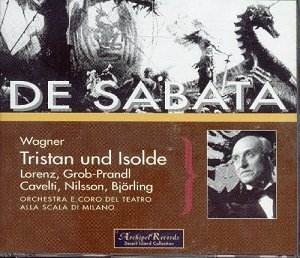 Composer: Richard Wagner
Composer: Richard Wagner
Works: Tristan und Isolde (1865)
Performers: Gertrud Grob-Prandl (soprano – Isolde), Max Lorenz (tenor – Tristan), Elsa Cavelti (soprano – Brangäne), Siegurd Bjorling (baritone – Kurwenal), Sven Nilsson (bass – King Marke)
Recording: Recorded live at La Scala, Milan, 13th December 1951
Label: Archipel Records ARPCD 0027-3
Wagner’s Tristan und Isolde stands as a monumental work in the operatic canon, not only for its profound exploration of love and death but also for its revolutionary harmonic language that has influenced generations of composers. This particular recording, conducted by Victor de Sabata and featuring a cast that includes the fervent Gertrud Grob-Prandl as Isolde and the impassioned Max Lorenz as Tristan, provides listeners with a visceral experience that captures the essence of Wagner’s vision. Originally available on LP in 1978 and subsequently on CD in 1989, its re-emergence on Archipel offers an invaluable opportunity to re-evaluate this landmark performance.
De Sabata, known for his electrifying conducting style, creates an intoxicating soundscape that is at once tempestuous and lyrical. His interpretation is characterized by a relentless drive, particularly evident in the Prelude to Act I. The orchestra’s playing, while occasionally marred by the limitations of the recording quality, bursts forth with a passionate intensity that is both compelling and overwhelming. The engineering, though lacking the clarity of modern recordings, allows the listener to appreciate the raw emotional power of the performance. This is particularly striking in the Act III Prelude, where the orchestra conveys Tristan’s despair with a tragic poignancy that resonates deeply, despite the sound’s inherent roughness.
The performance, while not without its flaws, is marked by an unyielding commitment to the music’s emotional core. Grob-Prandl’s Isolde, youthful and vibrant, brings a fresh perspective to the role, though her interpretation occasionally veers towards a dogmatic delivery, particularly in the curse scene. Max Lorenz, while possessing a splendid tenor voice, struggles at times under de Sabata’s fiery direction, especially in the frenetic pace of Act II. This act, in particular, suffers from both drastic cuts and the overwhelming speed, which can obscure the narrative’s structural integrity. Here, the wildness of de Sabata’s conducting, while exhilarating, can lead to a loss of clarity and coherence.
Comparatively, this recording stands apart from other notable interpretations, such as those by Karl Böhm and Herbert von Karajan, who offer a more measured and expansive approach to pacing. The flexibility and dramatic contrasts in Bernstein’s interpretation with the Bavarian Radio Symphony Orchestra exemplify a different interpretation that adheres more closely to Wagner’s written tempo indications. De Sabata’s performance, although incendiary and thrilling, risks sacrificing the delicate balance of tension and release that Wagner meticulously crafted. The extensive cuts throughout the opera, particularly in Act II, further detract from the overall experience, reducing the depth of character development and emotional arcs.
This recording of Tristan und Isolde remains an indispensable artifact of mid-20th-century operatic performance, capturing the essence of Wagner’s work through de Sabata’s fiery lens. While the technical challenges of the sound quality and the interpretative choices may limit its accessibility to some listeners, the sheer emotional impact and dramatic urgency found within these performances are undeniable. For those seeking an exhilarating journey into Wagner’s landscape of longing and despair, this release is a vital addition to any collection—one that vividly embodies the opera’s haunting beauty and tragic intensity, securing its place as a notable contender in the legacy of recorded performances.



